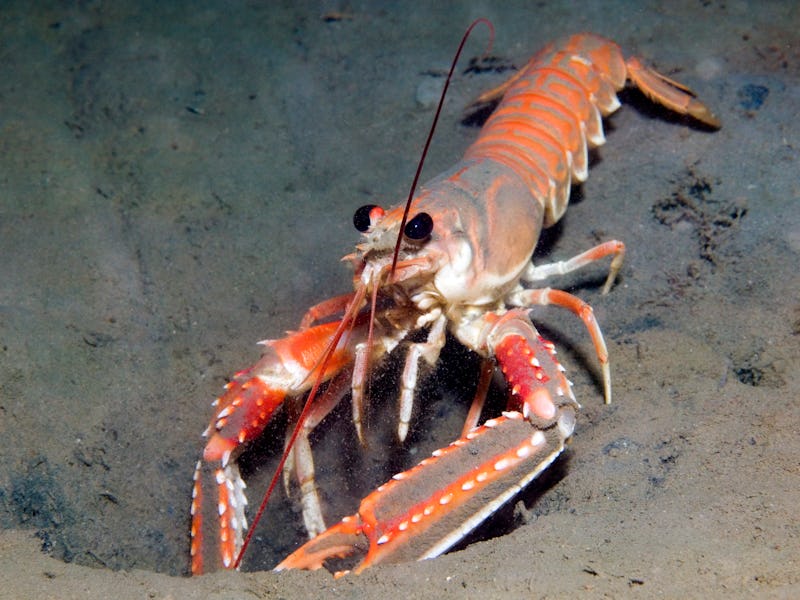Researchers are bugging the deep ocean to save this elusive sea creature
Anyone down there?

Norwegian lobsters are one of Europe's most important natural resources, but they are by their very nature elusive and isolated. As a result, keeping track of these crustaceans as they roam across the seafloor is a serious challenge.
Unlike large marine animals like dolphins or sea turtles which can have a GPS tracker strapped on to their bodies for tracking and population conservation, diving down to the bottom of the ocean to find and track these small, pink lobsters is much more difficult.
To overcome this, scientists are instead using underwater robots to essentially bug the lobsters. Using a combination of acoustics and autonomous underwater robots, they appear to have set up a perfect lobster-tracking operation. The system could help ecologists better understand and address threats to these lobsters' survival — and help the species thrive while still providing plenty to hungry European tables.
The results of their research are published Wednesday in the journal Science Robotics.
Like any high-profile, international star, Norweigan lobsters need plenty of rest to ensure they're able to perform for adoring crowds — in this case, to ensure there's enough to sell at the local fish market. When there is so much demand for these lobsters, which are also known as langoustine or Dublin Bay prawns, overfishing is a real concern. The study's lead author and postdoctoral researcher at the SARTI Research Group at Universitat Politècnica de Catalunya, Ivan Masmitja, tells Science Robotics in an accompanying statement that it's important to create no-take zones for these lobsters.
"The use of Marine Reserves areas — no-take zones — are crucial to preserve the biodiversity of our oceans," Masmitja says.
"One of the main problems for some species — e.g. Norway lobsters, the most important commercial crustacean at European level due to its economic value — is overfishing. These no-take zones will allow the recovery of damaged ecosystems."
Instead of GPS trackers, researchers relied on acoustic tracking to spy on these lobsters.
See also: How a young, black marine biologist turned her imposter syndrome into real change
To make no-take zones work for the lobsters, ecologists need to be able to accurately track the movement of these crustaceans far beneath the water's surface.
"Autonomous vehicles are and will be the future for exploring our oceans!"
Lobsters live very deep in the water, which can garble traditional tracking signals. They also don't often resurface, which makes it hard to apply a tracker in the first place. While scientists have succeeded in putting backpacks on bees, ensuring this crucial resource is protected required a little more innovation, Masmitja says — especially when they live in somewhere as difficult to get to for humans as the seafloor.
Spying on lobsters — The researchers decided to focus on using acoustic tracking instead of GPS tracking to listen to the lobsters and work out their location.
Similar to how a bat finds prey through echolocation, acoustic tracking measures the distance something is from the tracker by calculating how far sound waves have traveled between them.
In the paper, the researchers describe trials in which they listened to sound waves emitted from 33 tagged lobsters, and used these data to triangulate their position.
Researchers used a mix of roving robots and deep sea anchored receivers to track the lobsters.
To get close enough to listen in, the team used anchored, deep-sea sound receivers, as well as roving receivers mounted on underwater robots.
Over the course of three months, the researchers worked to refine algorithms to best process the acoustic data coming in from their various receivers. They found that two algorithms — area-only target tracking and time difference of arrival — enabled them to accurately track the lobsters within only a few meters error.
Researchers carefully lower their autonomous underwater robots into the ocean.
What's next — There are still bugs in the system. The researchers have no way to spy on lobsters when they retreat to their sandy burrows, for example. But Masmitja is excited about what these results could mean for a new era of conservation, in which undersea robots rove the oceans.
"The most exciting [aspect of this] is the use of underwater robots to help and boost target tracking techniques," he says.
"At this point, traditional localization methods, such as mooring receivers, are still necessary, however the use of robotized platforms can improve their inherent limitations and bring new capabilities... [But] autonomous vehicles are and will be the future for exploring our oceans!"
Abstract: Knowing the displacement capacity and mobility patterns of industrially exploited (i.e., fished) marine resources is key to establishing effective conservation management strategies in human-impacted marine ecosystems. Acquiring accurate behavioral information of deep-sea fished ecosystems is necessary to establish the sizes of marine protected areas within the framework of large international societal programs (e.g., European Community H2020, as part of the Blue Growth economic strategy). However, such information is currently scarce, and high-frequency and prolonged data collection is rarely available. Here, we report the implementation of autonomous underwater vehicles and remotely operated vehicles as an aid for acoustic long-baseline localization systems for autonomous tracking of Norway lobster (Nephrops norvegicus), one of the key living resources exploited in European waters. In combination with seafloor moored acoustic receivers, we detected and tracked the movements of 33 tagged lobsters at 400-m depth for more than 3 months. We also identified the best procedures to localize both the acoustic receivers and the tagged lobsters, based on algorithms designed for off-the-shelf acoustic tags identification. Autonomous mobile platforms that deliver data on animal behavior beyond traditional fixed platform capabilities represent an advance for prolonged, in situ monitoring of deep-sea benthic animal behavior at meter spatial scales.
This article was originally published on